Louisiana
state, United States
Introduction
Louisiana, flag of
 constituent state of the United States of America (United States). It is delineated from its neighbours— Arkansas to the north, Mississippi to the east, and Texas to the west—by both natural and man-made boundaries. The Gulf of Mexico (Mexico, Gulf of) lies to the south. The area of Louisiana includes more than 3,000 square miles (7,770 square km) of inland waters. The capital is Baton Rouge.
constituent state of the United States of America (United States). It is delineated from its neighbours— Arkansas to the north, Mississippi to the east, and Texas to the west—by both natural and man-made boundaries. The Gulf of Mexico (Mexico, Gulf of) lies to the south. The area of Louisiana includes more than 3,000 square miles (7,770 square km) of inland waters. The capital is Baton Rouge.

 constituent state of the United States of America (United States). It is delineated from its neighbours— Arkansas to the north, Mississippi to the east, and Texas to the west—by both natural and man-made boundaries. The Gulf of Mexico (Mexico, Gulf of) lies to the south. The area of Louisiana includes more than 3,000 square miles (7,770 square km) of inland waters. The capital is Baton Rouge.
constituent state of the United States of America (United States). It is delineated from its neighbours— Arkansas to the north, Mississippi to the east, and Texas to the west—by both natural and man-made boundaries. The Gulf of Mexico (Mexico, Gulf of) lies to the south. The area of Louisiana includes more than 3,000 square miles (7,770 square km) of inland waters. The capital is Baton Rouge.Admitted to the union in 1812 as the 18th state, Louisiana commands a once strategically vital region where the waters of the great Mississippi (Mississippi River)-Missouri (Missouri River) river system, draining the continental interior of North America, flow out into the warm, northward-curving crescent of the Gulf of Mexico. It is not surprising that seven flags have flown over its territories since 1682, when the explorer René-Robert Cavelier, sieur (lord) de La Salle (La Salle, René-Robert Cavelier, sieur (lord) de), placed a wooden cross in the ground and claimed the territory in the name of France's Louis XIV. The consequent varieties of cultural heritage run like bright threads through many facets of the social, political, and artistic life of the state.
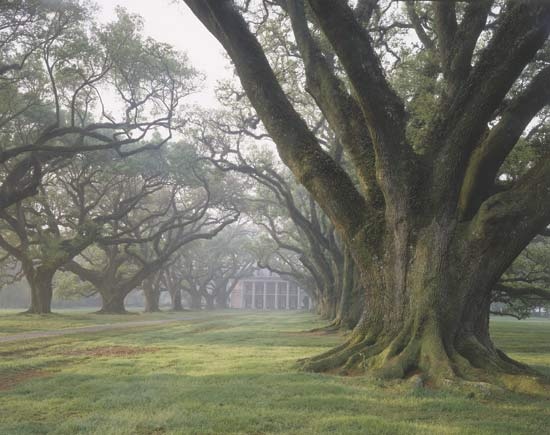 With parts of its land lying farther south than any portion of the continental United States except southern Texas and the Florida peninsula, and with New Orleans, its largest city, lying on roughly the same parallel as Cairo, New Delhi, and Shanghai, Louisiana owes much of its complex personality to its geographic position. The subtropical climate of the state has provided the magnificent brooding scenery of the coastal bayous, and the lush, dank vegetation of its shores conceals a wealth of petroleum and natural gas. The fertile soil covering much of the terrain made Louisiana a rich agricultural area by 1860, with flourishing sugarcane and cotton plantations. A lumber boom occurred at the turn of the 20th century, and Louisiana underwent rapid industrialization after World War II. Mineral output is great, and the state ranks among the country's leaders in oil and gas production.
With parts of its land lying farther south than any portion of the continental United States except southern Texas and the Florida peninsula, and with New Orleans, its largest city, lying on roughly the same parallel as Cairo, New Delhi, and Shanghai, Louisiana owes much of its complex personality to its geographic position. The subtropical climate of the state has provided the magnificent brooding scenery of the coastal bayous, and the lush, dank vegetation of its shores conceals a wealth of petroleum and natural gas. The fertile soil covering much of the terrain made Louisiana a rich agricultural area by 1860, with flourishing sugarcane and cotton plantations. A lumber boom occurred at the turn of the 20th century, and Louisiana underwent rapid industrialization after World War II. Mineral output is great, and the state ranks among the country's leaders in oil and gas production.But progress has not been without its tragic and turbulent aspects: bitter territorial disputes and violent internal struggles for political power impeded the social and economic development of the state and crippled many of its political institutions. The wealth of the plantations was accumulated through the extensive use of slaves, whose descendants comprise nearly one-third of Louisiana's population and whose culture has contributed much to the social fabric of the state. Racial conflict marked the development of the state from the American Civil War period (1861–65) and Reconstruction (1865–77) through the civil rights movement of the 1950s and '60s. The guarantee of suffrage (through the Voting Rights Act 【1965】) and ever-increasing African American political involvement, however, have helped move the state toward being a more racially egalitarian society.
Since the 1960s the state's economy, tied closely to the fluctuating oil industry, has experienced slower economic growth and less diversification than many other Southern states. More recently, corruption in state politics and an explosion of crime in the New Orleans area have marred that city's colourful image. Although the rich cultural heritage of the state is still enjoyed by many, tourism declined precipitously and businesses and residents suffered major losses after Hurricane Katrina devastated parts of the Gulf Coast (including New Orleans and other parts of Louisiana) in August 2005. Area 47,716 square miles (123,584 square km). Pop. (2000) 4,468,976; (2007 est.) 4,293,204.
Land
Relief
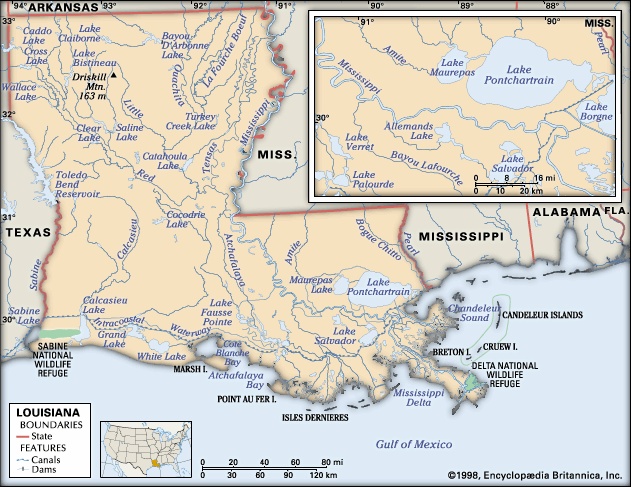

 Three types of regions are found in Louisiana: lowlands, terraces, and hills. The lowlands consist of the coastal marshes and the Mississippi floodplain, with its natural levees and moderate relief. The Red River valley has a low-elevation relief, with red soils in its alluvial plain and many raft lakes built by impounding water from logjams. The terraces include much of the so-called Florida Parishes to the north and northeast of the Mississippi delta, as well as the prairies of southwestern Louisiana. Hills flank the Red River valley and lend contour to the northern portion of the Florida Parishes; the state's highest point is Driskill Mountain (535 feet 【163 metres】), in northwestern Louisiana.
Three types of regions are found in Louisiana: lowlands, terraces, and hills. The lowlands consist of the coastal marshes and the Mississippi floodplain, with its natural levees and moderate relief. The Red River valley has a low-elevation relief, with red soils in its alluvial plain and many raft lakes built by impounding water from logjams. The terraces include much of the so-called Florida Parishes to the north and northeast of the Mississippi delta, as well as the prairies of southwestern Louisiana. Hills flank the Red River valley and lend contour to the northern portion of the Florida Parishes; the state's highest point is Driskill Mountain (535 feet 【163 metres】), in northwestern Louisiana.Drainage

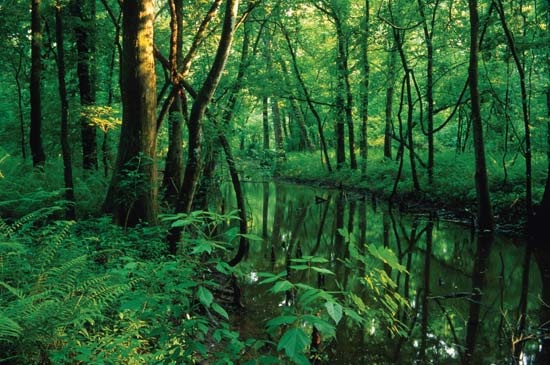 Louisiana shares the general physiographic characteristics common to the Gulf Coast states of the southern United States, with the vital exception of the Mississippi River, which borders and then flows through the state and extends its delta far into the Gulf of Mexico. The changing course of this great North American river has created the huge Atchafalaya River basin and has dumped tons of sediment along the coast. Despite this, the beachless coast of Louisiana is eroding; at the end of the 20th century, land was vanishing at a rate of about 24 square miles (62 square km) per year. This loss has been caused in part by the system of levees (or embankments) constructed by the federal government to keep the Mississippi in a central channel, which left side channels open to erosion. In 2005 Hurricane Katrina (Katrina, Hurricane) eroded an additional 73 square miles (189 square km) of the Louisiana coastland.
Louisiana shares the general physiographic characteristics common to the Gulf Coast states of the southern United States, with the vital exception of the Mississippi River, which borders and then flows through the state and extends its delta far into the Gulf of Mexico. The changing course of this great North American river has created the huge Atchafalaya River basin and has dumped tons of sediment along the coast. Despite this, the beachless coast of Louisiana is eroding; at the end of the 20th century, land was vanishing at a rate of about 24 square miles (62 square km) per year. This loss has been caused in part by the system of levees (or embankments) constructed by the federal government to keep the Mississippi in a central channel, which left side channels open to erosion. In 2005 Hurricane Katrina (Katrina, Hurricane) eroded an additional 73 square miles (189 square km) of the Louisiana coastland.Soils
The soils of Louisiana have been one of the state's priceless resources; more than one-fourth of the total land area is covered by the rich alluvium deposited by the overflowing of its rivers and bayous. Muck and peat soils are found within the coastal marshes, while the bottoms hold rich alluvial soils: the lighter and coarser bottom soils of the Mississippi and Red River valleys and the older alluvium and loessial, or windblown, soils. Within the uplands, or hills, there are more-mature soils that are less fertile.
Climate
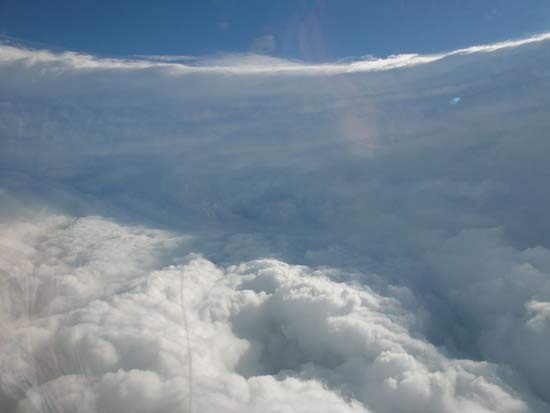 Louisiana's climate is subtropical, a natural result of its location on the Gulf of Mexico. As it also lies at the mouth of the vast Mississippi-Missouri river valley, roughly halfway between the Atlantic and the Pacific oceans, the state is also affected by continental weather patterns. Hot, humid summers, tempered by frequent afternoon thunder showers, alternate with mild winters. Louisiana is subject to tropical storms, and the hurricane season extends for six months, from June through November. Average annual temperatures range from 64 °F (18 °C) in the extreme north of the state to 71 °F (21 °C) at the mouth of the Mississippi River. The highest monthly average is 82 °F (28 °C) in July, and the lowest is 50 °F (10 °C) in January. In summer it is the humidity, rather than the heat, that is one of the more marked characteristics of the state's subtropical climate. The frost season falls roughly between November 1 in northern Louisiana and December 14 in the extreme southeast. The average growing season ranges from 220 to 320 days and the average precipitation ranges from almost 45 inches (1,140 mm) at Shreveport to more than 56 inches (1,420 mm) at New Orleans.
Louisiana's climate is subtropical, a natural result of its location on the Gulf of Mexico. As it also lies at the mouth of the vast Mississippi-Missouri river valley, roughly halfway between the Atlantic and the Pacific oceans, the state is also affected by continental weather patterns. Hot, humid summers, tempered by frequent afternoon thunder showers, alternate with mild winters. Louisiana is subject to tropical storms, and the hurricane season extends for six months, from June through November. Average annual temperatures range from 64 °F (18 °C) in the extreme north of the state to 71 °F (21 °C) at the mouth of the Mississippi River. The highest monthly average is 82 °F (28 °C) in July, and the lowest is 50 °F (10 °C) in January. In summer it is the humidity, rather than the heat, that is one of the more marked characteristics of the state's subtropical climate. The frost season falls roughly between November 1 in northern Louisiana and December 14 in the extreme southeast. The average growing season ranges from 220 to 320 days and the average precipitation ranges from almost 45 inches (1,140 mm) at Shreveport to more than 56 inches (1,420 mm) at New Orleans.Plant and animal life
 Natural vegetation in Louisiana is found in three major divisions: the first consists of forest, upland pines and hardwoods, bottomland hardwoods, and bald cypress; the second consists of prairie, or dry grassland; and the third consists of marshland, or wet grassland. In the southern half of the state, along a zone running westward from Baton Rouge, live oaks with their characteristic drapings of Spanish moss predominate. The magnolia, whose blossom is the state flower, grows throughout the state.
Natural vegetation in Louisiana is found in three major divisions: the first consists of forest, upland pines and hardwoods, bottomland hardwoods, and bald cypress; the second consists of prairie, or dry grassland; and the third consists of marshland, or wet grassland. In the southern half of the state, along a zone running westward from Baton Rouge, live oaks with their characteristic drapings of Spanish moss predominate. The magnolia, whose blossom is the state flower, grows throughout the state.Muskrats and other fur-bearing rodents, together with alligators, have been trapped in the marshes of southern Louisiana. There is a great variety of birds, native and migrant, but the once-frequent brown pelican (the state bird) has become an endangered species. The gray squirrel, deer, and dove are plentiful. Fish, shrimp, crayfish, crabs, and oysters are a source of food and income in the coastal and swamp areas.
People
Population (Louisiana) composition
As a diversity of landscapes and forms of settlement characterizes the state, its peoples and its cultures also represent many Louisianas. The earliest European settlers were French or Spanish; only later did “les Américains” settle in the northern part of the state and in the Florida Parishes. Each area of settlement preserved a cultural heritage strongly marked by adherence to either Roman Catholic or Protestant faith. The Louisiana French, particularly the descendants of the Acadians (most of whom were French settlers deported by the British from Canada in the 1700s), came to dominate much of southern Louisiana; many of those who arrived to live among them have been assimilated to the local Cajun (etymologically derived from Acadian) way of life. The Cajun French dialect is spoken in many parishes, and throughout southern Louisiana one may hear English spoken with a French accent. In addition, there are a number of cultural islands in both the northern and southern regions of the state. These are made up of Italian, Spanish (Isleños), Hungarian, German, and Dalmatian-Slavonian communities. There are also ethnically mixed settlements.
From the earliest days of the state, African Americans have played an important role. Prior to the mid-20th century, the African American population was concentrated in the areas surrounding the plantations that were sustained by their labour. In contemporary Louisiana, the greater portion of the African American community has chosen to pursue nonagricultural work in urban and suburban areas. Although Louisiana's African American population has been denied many of the traditional avenues leading to social and economic power, their culture has nevertheless contributed immensely to the life and character of the state and of New Orleans.
Louisiana's patterns of historical settlements have generated not only a unique Cajun culture but also an ethnically and linguistically distinct Creole culture of mixed French, African American, and Native American heritage. Based on—but distinct from—the French language, the Louisiana Creole language is itself a reflection of the diverse heritage of its speakers. Later migration to and through New Orleans from Europe, Latin America, and Cuba further enriched the state's ethnic diversity, which has always been greater than that of other states of the Deep South (South, the).
Settlement patterns
 Northern Louisiana forms a natural region including the northeastern Louisiana delta, the Red River valley, and the northern Louisiana hills. Southern Louisiana, composed of the parish of Avoyelles and all the parishes that lie south of latitude 31° N, has three major subregions: (1) the Florida Parishes in the east, (2) southwestern Louisiana, which contains many Anglo-Saxon Protestants but also has an important French minority, and (3) a region in between, variously known as Cajun country, the river and bayou country, or the sugar bowl.
Northern Louisiana forms a natural region including the northeastern Louisiana delta, the Red River valley, and the northern Louisiana hills. Southern Louisiana, composed of the parish of Avoyelles and all the parishes that lie south of latitude 31° N, has three major subregions: (1) the Florida Parishes in the east, (2) southwestern Louisiana, which contains many Anglo-Saxon Protestants but also has an important French minority, and (3) a region in between, variously known as Cajun country, the river and bayou country, or the sugar bowl.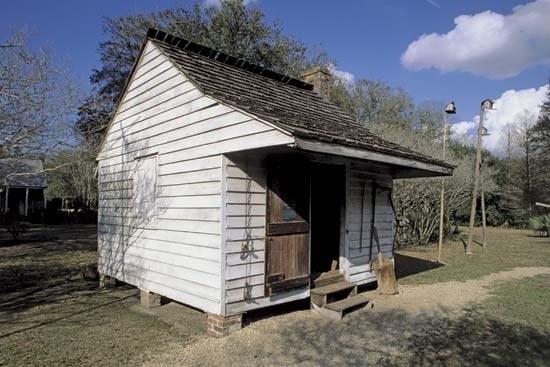 The earliest settlements in the river and bayou parishes were “line” villages, where farmsteads were each built at the riverfront of a long and narrow lot, with the stream serving as a highway. The line village pattern contrasted with the irregular pattern stemming from the ancient land-division system of metes and bounds used by the Anglo-Saxons of the Florida Parishes. Where the natural levee was wide enough, plantations were established. Before the Civil War, people came to the uplands of northern Louisiana from the eastern states and settled in isolated farmsteads among the pine woods. Southwestern Louisiana was developed after 1880, and its prairies were converted into rice fields. Settlement there resembled a grid system of land division found throughout the interior of the United States.
The earliest settlements in the river and bayou parishes were “line” villages, where farmsteads were each built at the riverfront of a long and narrow lot, with the stream serving as a highway. The line village pattern contrasted with the irregular pattern stemming from the ancient land-division system of metes and bounds used by the Anglo-Saxons of the Florida Parishes. Where the natural levee was wide enough, plantations were established. Before the Civil War, people came to the uplands of northern Louisiana from the eastern states and settled in isolated farmsteads among the pine woods. Southwestern Louisiana was developed after 1880, and its prairies were converted into rice fields. Settlement there resembled a grid system of land division found throughout the interior of the United States.By the early 21st century southern Louisiana contained nearly three-fourths of the state's population. A predominantly urban population was achieved for the first time in 1950. Since then the vast majority of Louisianans have been urban dwellers, mostly in the Greater New Orleans area and Baton Rouge, the seat of state government and the centre of the chemical industry. Other urban concentrations are located in Lafayette in the south-central part of the state and at Shreveport in the northwest. Much of northern and western Louisiana is sparsely populated.
Demographic trends
Louisiana has experienced some significant demographic changes in the 20th century. Prior to World War II many African Americans migrated to other states; after the war much of the remaining African American population left Louisiana's rural farmlands for its urban areas. African Americans now constitute nearly one-third of the state's residents. Whites (i.e., those of European ancestry) account for nearly two-thirds of the state's population. A fraction of the populace is Hispanic, and an even smaller segment is of Asian or Pacific Islander descent. The number of foreign-born residents of Louisiana declined over the 20th century, leaving some four-fifths of the population composed of native-born Louisianans. The vast majority of foreign-born residents live within the urbanized parishes of the state, especially in New Orleans.
Economy
Louisiana's economy was based mainly on agriculture in the 1700s and 1800s, with cotton as the primary crop in the northern part of the state and sugarcane the principal crop in the south. Lumbering began to grow in the late 1800s and remained a major part of the state's economy into the 21st century.
World War II hastened the industrial growth of Louisiana to the extent that the numbers of the labour force engaged in manufacturing increased considerably. Petroleum and natural gas extraction also grew rapidly. Chemical production, based on the state's readily available hydrocarbons, sulfur, salt, and water resources, boomed between 1947 and 1957, when the first big move to offshore petroleum production was made. Later in the 20th century, expansion of service opportunities—especially in tourism, retail, and government—helped position the service sector as the state's top employer. Despite these developments, Louisiana's economic growth has been slower than that of most other states and has trailed well behind the national average.
Agriculture and forestry
Agriculture is much less important to Louisiana's economy than it was earlier in the state's history. Only a small fraction of residents earn their living on farms, and most of the production comes from relatively few large farms in the alluvial plains of the Mississippi River. Cotton, sugarcane, rice, soybeans, corn (maize) and feed grains, and sweet potatoes are the main agricultural crops produced in the state. Poultry and eggs, beef cattle, and dairy products are also important. Tree farming, catalyzed by conservation efforts, is now the most valuable agricultural activity. Louisiana is among the top timber producers in the country. The vast majority of the state's trees are softwoods (pines), harvested primarily for making wood pulp and plywood.
Resources and power
Petroleum resources are found in the southern and northwestern parts of the state; the main oil fields have been developed between Shreveport and Monroe. Drilling was moved out into the gulf in the mid-20th century. natural gas resources have also been exploited. Including offshore drilling in federal waters, Louisiana ranks high in the production of both crude petroleum and natural gas. The petroleum industry was severely damaged by Hurricane Katrina (Katrina, Hurricane) in August 2005, but by late 2006 it had nearly regained pre-hurricane production. Offshore drilling for natural gas also declined but rebounded quickly.
Oil in Louisiana is often found in association with numerous salt domes (blisterlike intrusions in the bedrock), and sulfur lies in the caprock overlying the salt. The state is a national leader in the production of salt and is also a major source of sulfur, sand, gravel, and clay.
Natural gas has long been the primary source of Louisiana's electricity, generating about half of the state's total supply. Coal-fired plants provide another one-fourth of Louisiana's energy. A smaller but nonetheless significant portion of energy comes from the state's nuclear power stations.
Manufacturing
Chemical, petroleum, and coal products are Louisiana's leading manufactures, and manufacturing accounts for roughly one-sixth of the gross domestic product. The chemical industry provides about one-third of all of the industrial activity in the state. The extraction and processing of petroleum and natural gas became the state's largest industrial activity in the 20th century, with much of the petroleum being converted to chemicals. The chemical industry is concentrated along the Mississippi River between Baton Rouge and New Orleans. Lumber and wood products, transportation equipment and metal products, and processed food are other important manufactured items.
Transportation
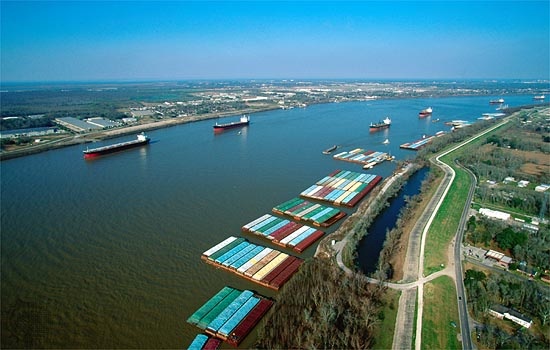 Louisiana's waterways have always been an important means of transportation. The state's vast system of navigable waterways include the Intracoastal Waterway. It is Louisiana's only east-west waterway and canal system and runs some 310 miles (500 km) from Mississippi Sound to the Sabine River. It is part of a larger waterway extending from the Caloosahatchee River in Florida to Brownsville, Texas. The port of New Orleans ranks among the busiest in the country in volume of seaborne freight, while Baton Rouge, farther up the Mississippi River at the head of deep-channel navigation, is important for shipping of petroleum and chemical products, including aluminum and grain.
Louisiana's waterways have always been an important means of transportation. The state's vast system of navigable waterways include the Intracoastal Waterway. It is Louisiana's only east-west waterway and canal system and runs some 310 miles (500 km) from Mississippi Sound to the Sabine River. It is part of a larger waterway extending from the Caloosahatchee River in Florida to Brownsville, Texas. The port of New Orleans ranks among the busiest in the country in volume of seaborne freight, while Baton Rouge, farther up the Mississippi River at the head of deep-channel navigation, is important for shipping of petroleum and chemical products, including aluminum and grain.Railroads (railroad) became common after the 1830s, initially as feeders to the steamboat traffic; the Clinton and Port Hudson line was the first railroad in the state. Railroading reached its peak in the early 20th century in connection with a feverish lumber boom, and there are nearly 3,000 miles (4,800 km) of track still in use in Louisiana. The state also has several thousand miles of highway. There are dozens of airports in Louisiana, though only a handful offer commercial flights. New Orleans International Airport, a leading continental link, is a major point of connection with Latin America.
Government and society
Constitutional framework
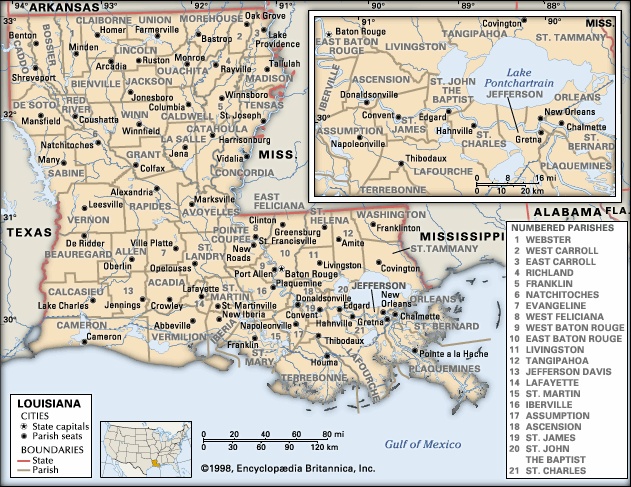
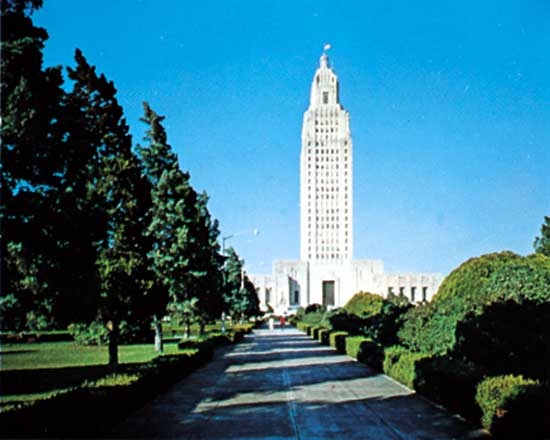 Louisiana's current constitution, its 11th, was adopted in 1974; it requires a two-thirds majority of each house of the state legislature, and then a majority of the electorate, to amend it. Louisiana has had more constitutions than any other state in the country. The constitution that was adopted in 1921 was Louisiana's 10th in 108 years. It remained in force for more than 50 years, a period during which the state underwent more fundamental change than had occurred in all the preceding years of statehood.
Louisiana's current constitution, its 11th, was adopted in 1974; it requires a two-thirds majority of each house of the state legislature, and then a majority of the electorate, to amend it. Louisiana has had more constitutions than any other state in the country. The constitution that was adopted in 1921 was Louisiana's 10th in 108 years. It remained in force for more than 50 years, a period during which the state underwent more fundamental change than had occurred in all the preceding years of statehood.The governor of Louisiana remains the state's most powerful official, not only from the weight of tradition (and personal performance) but also because of the extent of patronage among the many executive agencies, boards, commissions, and offices filled by gubernatorial appointment. The governor is elected to a term of four years and is permitted to serve no more than two consecutive terms. The lieutenant governor, secretary of state, attorney general, state treasurer, and superintendent of education are also elected to four-year terms, as are the agriculture, insurance, and elections commissioners. The Louisiana legislature has two houses: the Senate, with 39 members, and the House of Representatives, with 105 members. Legislators in both chambers are elected to four-year terms. The 1974 constitution retained a 1956 amendment that requires a two-thirds vote by both houses on taxation measures in order to curb spending by the governor.
Local self-government in Louisiana followed the Virginia system of county government. The parish (county), the municipality, and the special district are the units of local government. There are 64 parishes, with land areas that vary from roughly 180 square miles (466 square km) in Orleans parish near the city of New Orleans to more than 1,300 square miles (3,370 square km) in Cameron parish in the state's southwestern corner. The name of the elected parish governing board, the “police jury,” is not found anywhere else in the country.
There are about 300 incorporated municipalities in Louisiana, described as state units, which exercise narrowly construed powers. The charter of incorporation detailed by law outlines three classes of municipalities based on population: city (5,000 or more), town (1,001 to 4,999), and village (1,000 or less). Special districts established by the legislature provide for the administration of new or expanding functions of local government.
A 1975 statute mandated an open primary system for the election of state officers. Under this system, all candidates appear on a single ballot. The candidate who receives more than 50 percent of the votes in the primary is elected to office. If no candidate receives a majority of the vote, a runoff election is held between the two candidates who received the most votes; these candidates may be members of the same political party. Previously, Democratic nomination was tantamount to victory in the general election. In the open primary, however, the division of the Democratic vote by multiple candidates practically assured a runoff position for a lone Republican candidate. In consequence, Louisiana in 1979 elected its first Republican governor since Reconstruction.
The highest court in the state is the Supreme Court. Its seven justices are popularly elected for 10-year terms. Judges in the Court of Appeals, the district courts, and most of the lesser courts are also popularly elected.
Louisiana's legal system differs from that of the other 49 states in that it is based not on common law but on civil law, which is code, or written, law. The state draws on its colonial inheritance, in which the adopted code was based on the Napoleonic Code of France and further influenced by Spanish laws, both of which had a common source in Roman law. The civil law consists of broad principles drafted by authorities in various fields of law. In Louisiana the law is enacted in the constitution, which vests in the legislature the authority to make law, whereas the functions of the courts are limited to the application of the law to given sets of facts. Courts are not bound by previous decisions. The law governs all personal and property rights and has been extended to civil and criminal procedures.
Health and welfare
The legislature has established programs to provide a system of economic security and social welfare for various categories of citizens. The state gives aid and welfare to mothers and children and provides aid to people with disabilities. Various state departments provide some aspects of welfare aid, but by far the most important is the Department of Social Services, which provides services to Louisiana citizens through a central office in New Orleans and local units in parishes. Penal and correctional institutions operated by the state are administered under the general authority of the Department of Public Safety and Corrections. The penal system has often been subject to an excess of political interference.
The so-called Charity Hospital system, supported and administered by the state, is fairly unusual among the 50 states. The system maintains several general and psychiatric hospitals. The Charity Hospital of Louisiana, in New Orleans, founded by private endowment in 1736 and later adopted by the state, is one of the country's oldest public hospitals.
Education
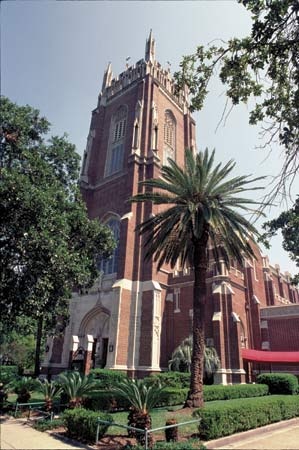 Louisiana has nearly two dozen public and about 10 private institutions of higher education. Louisiana State University (LSU; 1853), which is both the land-grant (land-grant college) and the arts and sciences university, is the keystone of the state system of higher education, with campuses in Baton Rouge, Eunice, Shreveport, and Alexandria. Its former campus, in New Orleans, has become the University of New Orleans (1856). Louisiana Tech University (1894), in Ruston, and the University of Louisiana at Monroe (Louisiana at Monroe, University of) (1931; university status, 1970) are among the other public universities, many of which grew from junior colleges in the 1930s and '40s. Southern University (1880), in Baton Rouge, with campuses also in Shreveport and New Orleans, is a public historically black institution, as is Grambling State University (1901), in Grambling. Private historically black schools include Dillard (1930) and Xavier (1915; Roman Catholic), both in New Orleans. Among other prominent private institutions in the city are Loyola University (1837; Catholic) and Tulane University (1834). A number of public and private institutions offer online degree programs.
Louisiana has nearly two dozen public and about 10 private institutions of higher education. Louisiana State University (LSU; 1853), which is both the land-grant (land-grant college) and the arts and sciences university, is the keystone of the state system of higher education, with campuses in Baton Rouge, Eunice, Shreveport, and Alexandria. Its former campus, in New Orleans, has become the University of New Orleans (1856). Louisiana Tech University (1894), in Ruston, and the University of Louisiana at Monroe (Louisiana at Monroe, University of) (1931; university status, 1970) are among the other public universities, many of which grew from junior colleges in the 1930s and '40s. Southern University (1880), in Baton Rouge, with campuses also in Shreveport and New Orleans, is a public historically black institution, as is Grambling State University (1901), in Grambling. Private historically black schools include Dillard (1930) and Xavier (1915; Roman Catholic), both in New Orleans. Among other prominent private institutions in the city are Loyola University (1837; Catholic) and Tulane University (1834). A number of public and private institutions offer online degree programs.Cultural life
Christian churches are important influences on Louisiana's cultural life, especially the Roman Catholic Church in southern Louisiana and the Baptists in northern Louisiana and among African Americans throughout the state. New Orleans and many smaller communities have been able to support the arts and philanthropic institutions. The Creoles (Creole) developed a distinctive architecture, art, and cuisine centred on New Orleans.
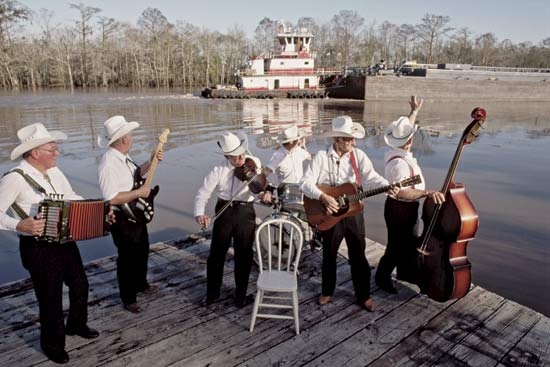 In rural culture and the arts, Louisiana more than holds its own. This is especially evident in the realm of music, whether it be African American song (including the celebrated rural blues), Cajun fiddling at the fais do-dos (country dances held in southern Louisiana), the Creole zydeco tradition, or the community hymn singing of northern Louisiana. The urban jazz style that was taken by New Orleans migrants to Chicago and elsewhere, as well as the Dixieland music played by bands at Preservation Hall in New Orleans, are also hallmarks of Louisiana's cultural heritage.
In rural culture and the arts, Louisiana more than holds its own. This is especially evident in the realm of music, whether it be African American song (including the celebrated rural blues), Cajun fiddling at the fais do-dos (country dances held in southern Louisiana), the Creole zydeco tradition, or the community hymn singing of northern Louisiana. The urban jazz style that was taken by New Orleans migrants to Chicago and elsewhere, as well as the Dixieland music played by bands at Preservation Hall in New Orleans, are also hallmarks of Louisiana's cultural heritage.Louisiana has produced a number of important literary figures, including Truman Capote (Capote, Truman) and Ernest J. Gaines (Gaines, Ernest J.). Many of Capote's earlier works were set in the South, while the bulk of Gaines's novels were cast specifically in Louisiana. Gaines's The Autobiography of Miss Jane Pittman (1971) was highly acclaimed for its depiction of rural life in Louisiana from an African American perspective.
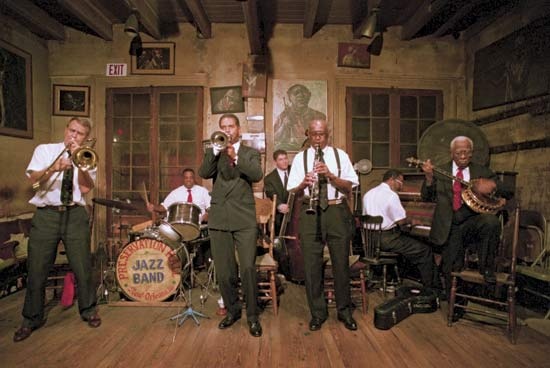 Since the early 19th century, New Orleans has been a major cultural centre of the United States. Its French Quarter has attracted such artists as John J. Audubon (Audubon, John James), the great wildlife painter, and George Catlin (Catlin, George), noted for his portrayals of the American West, and has been the haunt of writers such as Walt Whitman (Whitman, Walt), Sherwood Anderson (Anderson, Sherwood), and William Faulkner (Faulkner, William). The city has also been home to an opera company, as well as various symphony orchestras since the mid-20th century. Other cities, notably Shreveport, Monroe, Baton Rouge, and Lafayette, have established their own museums and galleries, orchestras, choruses, theatres, and other cultural institutions, especially since the 1930s.
Since the early 19th century, New Orleans has been a major cultural centre of the United States. Its French Quarter has attracted such artists as John J. Audubon (Audubon, John James), the great wildlife painter, and George Catlin (Catlin, George), noted for his portrayals of the American West, and has been the haunt of writers such as Walt Whitman (Whitman, Walt), Sherwood Anderson (Anderson, Sherwood), and William Faulkner (Faulkner, William). The city has also been home to an opera company, as well as various symphony orchestras since the mid-20th century. Other cities, notably Shreveport, Monroe, Baton Rouge, and Lafayette, have established their own museums and galleries, orchestras, choruses, theatres, and other cultural institutions, especially since the 1930s.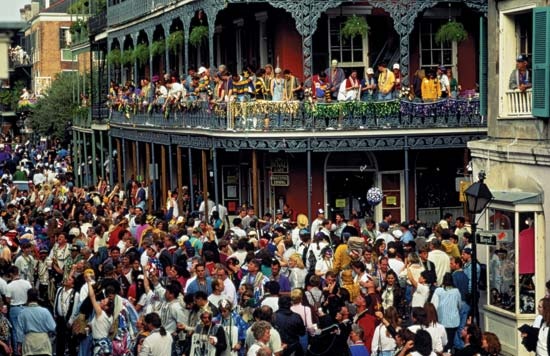
 Tourism has developed as an important component of the state's economy, using the appeal of the antebellum past and the attraction of Creole cuisine—a blend of French, Spanish, African American, and Native American dishes. A series of parades and balls culminating in Mardi Gras (Shrove Tuesday) has become a national attraction in New Orleans. There are many public parks and gardens, and the state is advertised as a sportsman's paradise for hunting and fishing.
Tourism has developed as an important component of the state's economy, using the appeal of the antebellum past and the attraction of Creole cuisine—a blend of French, Spanish, African American, and Native American dishes. A series of parades and balls culminating in Mardi Gras (Shrove Tuesday) has become a national attraction in New Orleans. There are many public parks and gardens, and the state is advertised as a sportsman's paradise for hunting and fishing. New Orleans is an important centre for both professional and collegiate sports. Tulane usually fields strong collegiate gridiron football teams, and the city is also home to the National Football League (NFL) Saints team. The Super Bowl NFL championship game has been played on multiple occasions in New Orleans, and the Sugar Bowl of collegiate football is held there annually (generally early in January). New Orleans also has a professional men's basketball team (the Hornets). In Baton Rouge, LSU has long been a powerhouse in both collegiate football and basketball. The state's larger cities also host a number of minor league football, baseball, and ice hockey teams.
New Orleans is an important centre for both professional and collegiate sports. Tulane usually fields strong collegiate gridiron football teams, and the city is also home to the National Football League (NFL) Saints team. The Super Bowl NFL championship game has been played on multiple occasions in New Orleans, and the Sugar Bowl of collegiate football is held there annually (generally early in January). New Orleans also has a professional men's basketball team (the Hornets). In Baton Rouge, LSU has long been a powerhouse in both collegiate football and basketball. The state's larger cities also host a number of minor league football, baseball, and ice hockey teams.The literate Creole culture provided the state with a long press tradition; the first newspaper, Le Moniteur de la Louisiane, appeared in 1794. Eight others were published in New Orleans at the turn of the 19th century, and the rural parishes likewise published their own papers. The New Orleans Times-Picayune, one of the state's oldest newspapers, has the largest circulation in Louisiana. There are about 20 other dailies published in the state. Louisiana is well served by numerous radio stations and nearly three dozen television stations.
History
Early settlement
Thousands of years before European exploration, various indigenous peoples occupied the region that later became Louisiana. There are prehistoric Indian archaeological sites, most notably of the Woodland culture at Poverty Point (designated both a state historic site and a national monument) and the Mississippian culture at Marksville (also a state historic site). Most Louisiana peoples lived in hunting and gathering camps in the uplands and coastal prairies, though there were farming villages in the rich low-lying areas known as bottoms. It is estimated that the native population was about 15,000 in the area when settlement by Europeans began during the 1700s. By 1980 only about one-fifth as many Native Americans remained. The heritage of Louisiana's original inhabitants is present in the many Native American place-names that lend colour to the state's map.
The first European known to have explored present-day Louisiana was the Spaniard Hernando de Soto (Soto, Hernando de) in 1541, but it was the French who later colonized the region. Serious colonization by France began in 1702, when Pierre Le Moyne d'Iberville (Iberville, Pierre Le Moyne d') and his brother Jean-Baptiste Le Moyne de Bienville (Bienville, Jean-Baptiste Le Moyne de) struggled to found permanent settlements. The city of New Orleans was established by Bienville in 1718. Royal charters covering the area had been granted, first to French merchant Antoine Crozat in 1712 and then in 1717 to the Scottish businessman John Law (Law, John), whose Company of the West failed in 1720. When Louisiana became a French crown colony in 1731, its population had grown from fewer than 1,000 to nearly 8,000, including slaves. In addition to the French settlers, many thousands of Germans arrived, settling on the river just above New Orleans on what became known as the German Coast. Colonization increased again during the 1760s with the arrival of the French-speaking Acadians, who had been expelled from Nova Scotia by the British.
In 1762 Louisiana and New Orleans were ceded to Spain by a secret treaty that was to establish nearly four decades of Spanish rule and influence in the area. In 1779 the Spanish wrested Baton Rouge from the British and took all of West Florida, which then extended from the peninsula westward across the Gulf Coast to the Mississippi River. In 1800 the Spanish returned Louisiana to France, and three years later the United States, under the leadership of Pres. Thomas Jefferson (Jefferson, Thomas), bought Louisiana from the French emperor Napoleon I. The Louisiana Purchase, a vast acquisition of land for the country, included New Orleans and much of present-day Louisiana state, as well as most of the territory between the Mississippi River and the Rocky Mountains.
The 19th century
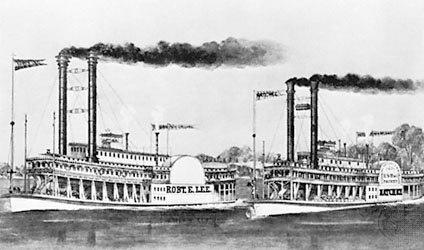 Louisiana was subsequently divided into the Territory of Orleans, which consisted essentially of the state within its present boundaries, and the Territory of Louisiana, which included all the vast area drained by the Mississippi and Missouri (Missouri River) rivers. In 1810 the Territory of Orleans consisted of 77,000 people, and statehood proposals were beginning to be heard. When in 1812 the territory petitioned to enter the union, the eastern region now called the Florida Parishes—where the people had rebelled against the Spanish and established the Republic of West Florida—was included. On April 30, 1812, Louisiana entered the union as the 18th state. Between December 1814 and January 1815, New Orleans was the site of the final battle of the War of 1812 (1812, War of), in which U.S. troops led by Gen. Andrew Jackson (Jackson, Andrew) defeated the British.
Louisiana was subsequently divided into the Territory of Orleans, which consisted essentially of the state within its present boundaries, and the Territory of Louisiana, which included all the vast area drained by the Mississippi and Missouri (Missouri River) rivers. In 1810 the Territory of Orleans consisted of 77,000 people, and statehood proposals were beginning to be heard. When in 1812 the territory petitioned to enter the union, the eastern region now called the Florida Parishes—where the people had rebelled against the Spanish and established the Republic of West Florida—was included. On April 30, 1812, Louisiana entered the union as the 18th state. Between December 1814 and January 1815, New Orleans was the site of the final battle of the War of 1812 (1812, War of), in which U.S. troops led by Gen. Andrew Jackson (Jackson, Andrew) defeated the British.After the war, settlers from the east rushed to New Orleans and other areas of the young state. New Orleans also became home to thousands of newly arrived immigrants from the West Indies, Germany, and Ireland. As the upper reaches of the Mississippi valley became more populated in the first half of the 19th century, New Orleans grew and prospered as the main trading centre of the western United States. Large amounts of grain, cotton, and meat came to New Orleans via steamboats on the rivers, and the city's merchants sold upriver a wide variety of goods that they imported into the city.
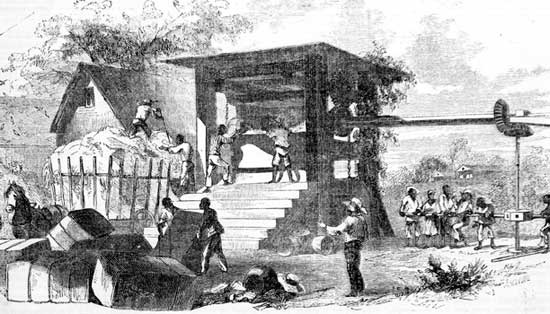 An agricultural boom took place, and cotton and sugarcane production expanded. Both crops were cultivated primarily by slaves of African descent, and a wealthy plantation society emerged. Small farmers' opposition to planters was apparent in Louisiana state politics, especially after settlement expanded in the hilly northwestern part of the state. Overall, the planters generally prevailed. Many Louisianans were uncertain about secession in 1860, but the state did join the Confederate States of America in 1861 as one of the original seven states in that union.
An agricultural boom took place, and cotton and sugarcane production expanded. Both crops were cultivated primarily by slaves of African descent, and a wealthy plantation society emerged. Small farmers' opposition to planters was apparent in Louisiana state politics, especially after settlement expanded in the hilly northwestern part of the state. Overall, the planters generally prevailed. Many Louisianans were uncertain about secession in 1860, but the state did join the Confederate States of America in 1861 as one of the original seven states in that union.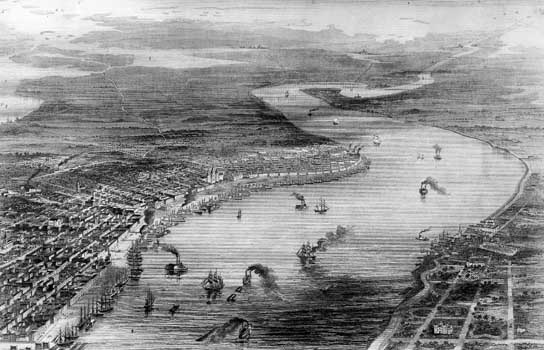 Southern Louisiana's separation from the Union was short-lived, and by May 1, 1862, New Orleans was occupied by Union army forces under Gen. Benjamin F. Butler (Butler, Benjamin F). The general, intolerant of the lack of cooperation that he received from some Louisianans in the occupied state, had at least one dissident hanged, his intention being to make local residents see clearly the costs of war. Soon Pres. Abraham Lincoln (Lincoln, Abraham) was encouraging the creation of a pro-U.S. state government in Louisiana so that it could reenter the union. Among the controversial issues was whether to give the state's African Americans the right to vote as part of a reconstructed Louisiana, a decision that Lincoln ultimately approved. Despite much debate and controversy, however, the state failed to rejoin the union until after the war ended. Wartime Louisiana foreshadowed the problems of emancipation and Reconstruction that awaited the rest of the South in the postwar period. In the years immediately following the war, ex-Confederates won control of the state government and instituted policies that severely limited the rights of newly freed slaves. However, with the official advent of Reconstruction in 1867, which brought U.S. control over state political matters, a new constitution was written that protected the political rights of African Americans. Louisiana was finally readmitted into the union in 1868.
Southern Louisiana's separation from the Union was short-lived, and by May 1, 1862, New Orleans was occupied by Union army forces under Gen. Benjamin F. Butler (Butler, Benjamin F). The general, intolerant of the lack of cooperation that he received from some Louisianans in the occupied state, had at least one dissident hanged, his intention being to make local residents see clearly the costs of war. Soon Pres. Abraham Lincoln (Lincoln, Abraham) was encouraging the creation of a pro-U.S. state government in Louisiana so that it could reenter the union. Among the controversial issues was whether to give the state's African Americans the right to vote as part of a reconstructed Louisiana, a decision that Lincoln ultimately approved. Despite much debate and controversy, however, the state failed to rejoin the union until after the war ended. Wartime Louisiana foreshadowed the problems of emancipation and Reconstruction that awaited the rest of the South in the postwar period. In the years immediately following the war, ex-Confederates won control of the state government and instituted policies that severely limited the rights of newly freed slaves. However, with the official advent of Reconstruction in 1867, which brought U.S. control over state political matters, a new constitution was written that protected the political rights of African Americans. Louisiana was finally readmitted into the union in 1868.Political conflict occurred between the Republicans (Republican Party) who were centred in New Orleans and the former Confederates from the rural parishes. Although they would soon dominate the Democratic Party, during the time between 1868 and 1876 the former Confederates relied heavily on extralegal terrorism that was organized by such groups as the Ku Klux Klan (KKK), the White Camellia, and the White League—all of which worked to create mayhem for the Republicans. They frequently murdered Republican candidates and officeholders. The U.S. army was the only force that was able to counter such terrorism. When the army was finally withdrawn from Louisiana in 1877 as part of a bargain to settle the contested presidential election of 1876, the anti-black, anti-Republican Louisianans secured their power in state politics. A new constitution was enacted in 1898 that disenfranchised nearly all African Americans, and a system of legalized discrimination, in the form of segregation, ensued shortly thereafter.
The plantation economy was re-created after the Civil War, but many small farmers, white and black alike, were unable either to buy land or to hold onto what they originally owned and were thus forced into sharecropping or tenancy (tenant farming). Agrarian protests that emerged during the 1880s and '90s produced the People's (Populist (Populist Movement)) Party and what seemed at the time to be a chance to overthrow the state's planter-merchant-lawyer rule. By the early 20th century, however, the elite were able to defeat the reform movement of the farmers and solidify conservative rule in Louisiana.
Louisiana since c. 1900
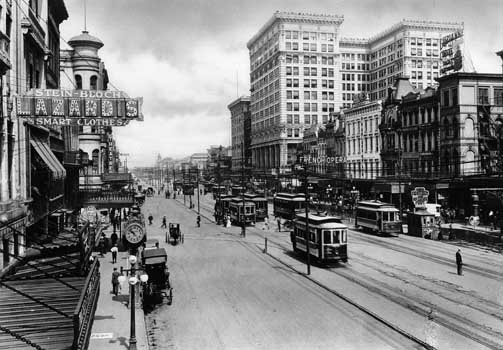 Louisiana's economy began to diversify significantly in the late 1800s with the emergence of a large timber industry, which continued as a major part of the state's economy into the 21st century. Extensive lumbering attracted large corporations to Louisiana for three decades following 1890, and the discovery of oil and gas reserves helped to increase industrial development. The conservative political leadership of the state refused to tax the extractive industries heavily, however, and the controversy that ensued helped propel the rise of the left-wing demagogue Huey Long (Long, Huey), who was elected governor and then senator beginning in the late 1920s. Through a ruthless political machine that he tightly controlled, Long dominated virtually every public decision made at the state level until his assassination in 1935.
Louisiana's economy began to diversify significantly in the late 1800s with the emergence of a large timber industry, which continued as a major part of the state's economy into the 21st century. Extensive lumbering attracted large corporations to Louisiana for three decades following 1890, and the discovery of oil and gas reserves helped to increase industrial development. The conservative political leadership of the state refused to tax the extractive industries heavily, however, and the controversy that ensued helped propel the rise of the left-wing demagogue Huey Long (Long, Huey), who was elected governor and then senator beginning in the late 1920s. Through a ruthless political machine that he tightly controlled, Long dominated virtually every public decision made at the state level until his assassination in 1935. With the support of the rural areas and the emerging working class, Long's administration raised welfare benefits and educational services and built many new bridges, roads, and hospitals. Long's political allies and his brother, Earl K. Long (elected governor in 1948 and 1956), perpetuated his liberal spending policies, and his legacy of public benefits financed by increased taxation has continued to some extent to the present day.
With the support of the rural areas and the emerging working class, Long's administration raised welfare benefits and educational services and built many new bridges, roads, and hospitals. Long's political allies and his brother, Earl K. Long (elected governor in 1948 and 1956), perpetuated his liberal spending policies, and his legacy of public benefits financed by increased taxation has continued to some extent to the present day.During and after World War II, Louisiana experienced significant new economic development, which was heavily concentrated in the petrochemical industry and increasingly concerned with offshore oil and natural gas drilling in the Gulf of Mexico. The growth of the petrochemical industry raised the overall prosperity of the state after 1940 and contributed heavily to a significant increase in personal income among state residents. In the 1930s and '40s, African Americans in Louisiana, led by a well-educated middle-class group of New Orleaners, began to challenge the entrenched system of segregation (segregation, racial), mainly by arguing against discrimination in the courts. Black Louisianans rose up against segregation more forcefully in the 1960s as part of the nationwide civil rights movement.
Louisiana's politics, although more open since the 1960s, have hardly lost their colourful, controversial character. The Republican Party has become more competitive in state politics, as evidenced by the election of Republican governors and members of Congress and the state legislature. One Republican, David Duke—an avowed white supremacist and former head of the KKK—was elected to a term (1989–93) in the Louisiana House of Representatives and has run for other state and federal offices. Edwin W. Edwards, a flamboyant Democrat who was elected governor four times between 1972 and 1992, enacted liberal policies but was often accused of public corruption; although acquitted of charges in the 1980s, he was convicted in 2000 of racketeering, fraud, and extortion.
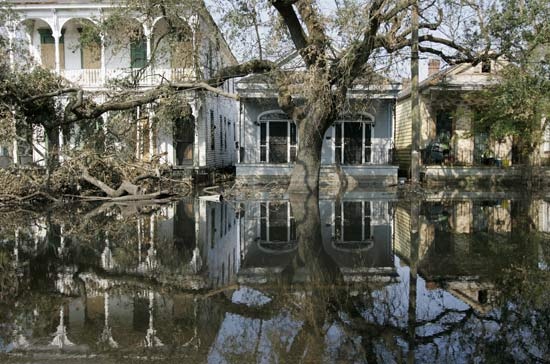 Since the 1970s Louisiana's economy has often sputtered, a reflection of its overdependence on the oil industry, which has tended to tie the state to boom-and-bust cycles. The state also failed to diversify into other industrial activities as fast as some other Southern states, and its service sector has lacked the dynamism of various neighbouring states on the Gulf Coast. The damage and devastation caused by Hurricane Katrina (Katrina, Hurricane) in August 2005 severely affected the state's economy and infrastructure—notably in southern Louisiana—although oil and gas extraction did rebound relatively quickly. After the disaster, the state began to rebuild and repair the affected areas with support from the federal government and a plethora of local and national organizations. Louisiana also introduced incentives to revitalize tourism, notably in the New Orleans area.
Since the 1970s Louisiana's economy has often sputtered, a reflection of its overdependence on the oil industry, which has tended to tie the state to boom-and-bust cycles. The state also failed to diversify into other industrial activities as fast as some other Southern states, and its service sector has lacked the dynamism of various neighbouring states on the Gulf Coast. The damage and devastation caused by Hurricane Katrina (Katrina, Hurricane) in August 2005 severely affected the state's economy and infrastructure—notably in southern Louisiana—although oil and gas extraction did rebound relatively quickly. After the disaster, the state began to rebuild and repair the affected areas with support from the federal government and a plethora of local and national organizations. Louisiana also introduced incentives to revitalize tourism, notably in the New Orleans area.Additional Reading
Books on the state's geography include Fred B. Kniffen and Sam Bowers Hilliard, Louisiana: Its Land and People, rev. ed. (1988), a concise cultural geography with maps and illustrations; and Louisiana Writers' Project, Louisiana: A Guide to the State (1941, reprinted 1976), also available in a new revised edition ed. by Harry Hansen (1971), an indispensable survey of life in Louisiana. DeLorme Mapping Company, Louisiana Atlas & Gazetteer (2003), focuses on topography; while Charles Robert Goins and John Michael Caldwell, Historical Atlas of Louisiana (1995), concentrates on historical geography. Glenn R. Conrad (ed.), The Cajuns, 3rd ed. (1983), presents essays on Acadian history and culture in Louisiana. Rudolf Heberle, The Labor Force in Louisiana (1948), provides a benchmark from which to study the state's industrial development. Roger W. Shugg, Origins of Class Struggle in Louisiana: A Social History of White Farmers and Laborers During Slavery and After, 1840–1875 (1939, reissued 1968), is a classic treatment of the political process from 1812 to the 1880s. James Bolner (ed.), Louisiana Politics: Festival in a Labyrinth (1982), highlights the structure and practice of Louisiana's government. Mark T. Carleton, Perry H. Howard, and Joseph B. Parker (comps.), Readings in Louisiana Politics, 2nd ed. (1988), provides classic statements of social, economic, and political history with accounts of developments from colonial status onward. Perry H. Howard, Political Tendencies in Louisiana, rev. and expanded ed. (1971), is a historical examination of social structure and voting behaviour. Peyton McCrary, Abraham Lincoln and Reconstruction: The Louisiana Experiment (1978), provides an excellent account of the state's conflicts during the American Civil War. T. Harry Williams, Huey Long (1969, reissued 1996), is a fascinating and sympathetic biography of the politician.Overviews of the state's history can be found in Alcée Fortier, A History of Louisiana, 4 vol. (1904), a classic; Joe Gray Taylor, Louisiana: A History, rev. ed. (1984), an introduction; and Noel Gray, A Short History of Louisiana (1965), which gives attention to the role of the African American community. Glenn R. Conrad (ed.), Readings in Louisiana History (1978), is comprehensive and includes maps and bibliographies. A helpful bibliography is Light Townsend Cummins and Glen Jeansonne (eds.), A Guide to the History of Louisiana (1982). Continuing scholarly research is presented in Louisiana History (quarterly). Adam Fairclough, Race and Democracy: The Civil Rights Struggle in Louisiana, 1915–1972 (1995), provides much new material on the civil rights movement in Louisiana.
- Oates, Joyce Carol
- Oates, Titus
- oat grass
- oath
- oats
- Oaxaca
- Obadiah, Book of
- Obadiah of Bertinoro
- Obafemi Awolowo
- Obama, Barack
- Obama, Michelle
- Obando, José María
- O'Bannion, Dion
- Obasanjo, Olusegun
- obbligato
- O.B.E.
- Obed Hussey
- Obelia
- obelisk
- Oberlin
- Oberlin College
- Oberlin, Johann Friedrich
- Oberon
- Oberon, Merle
- Oberth, Hermann